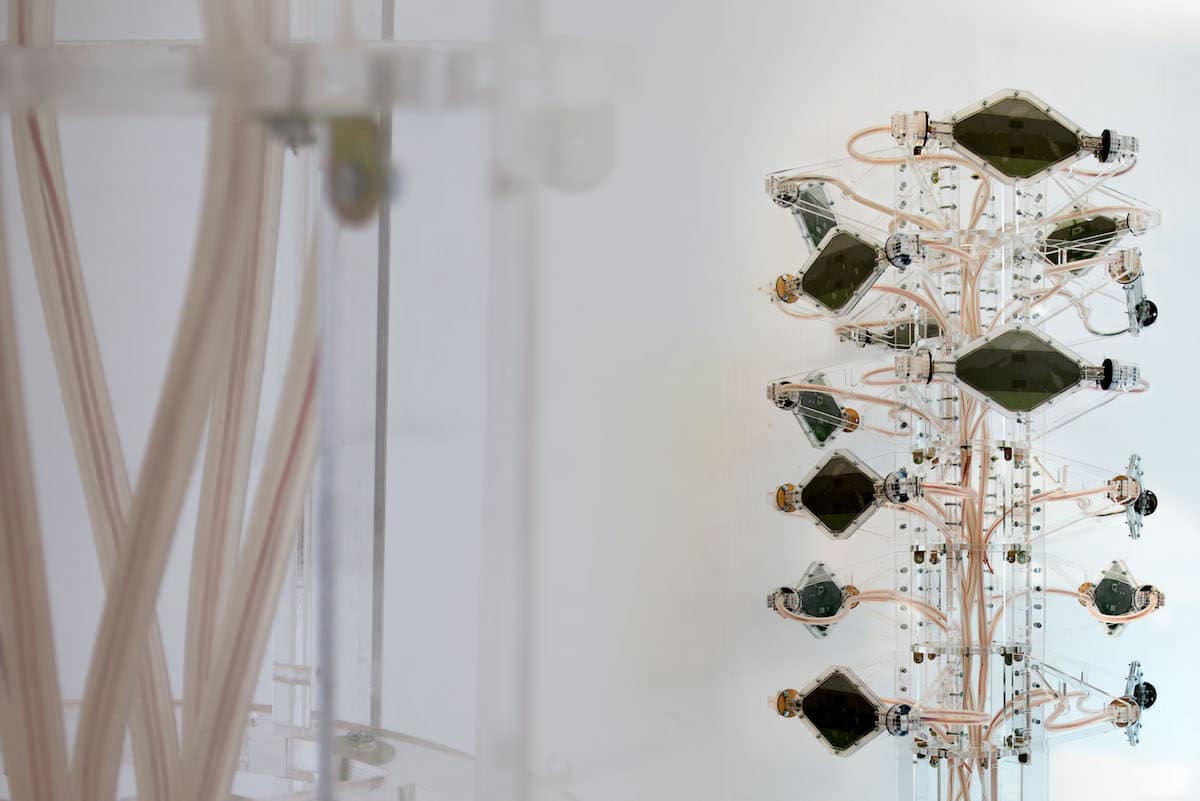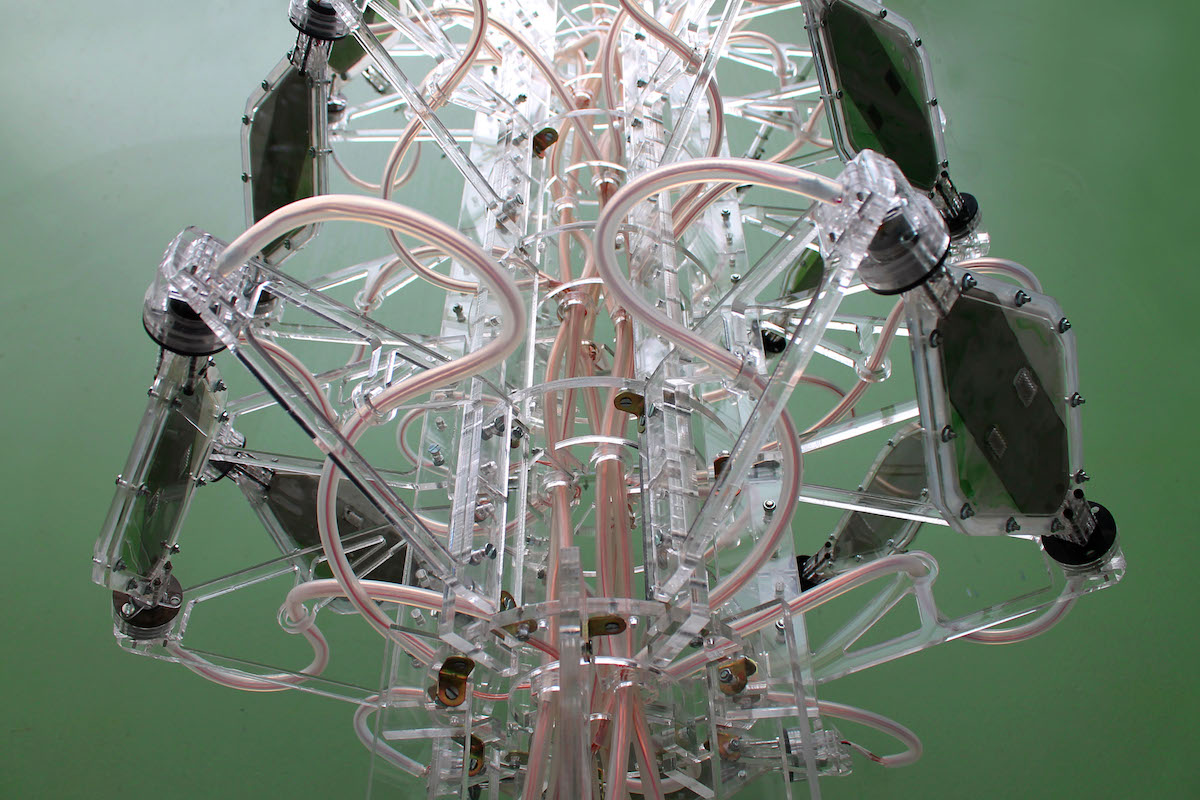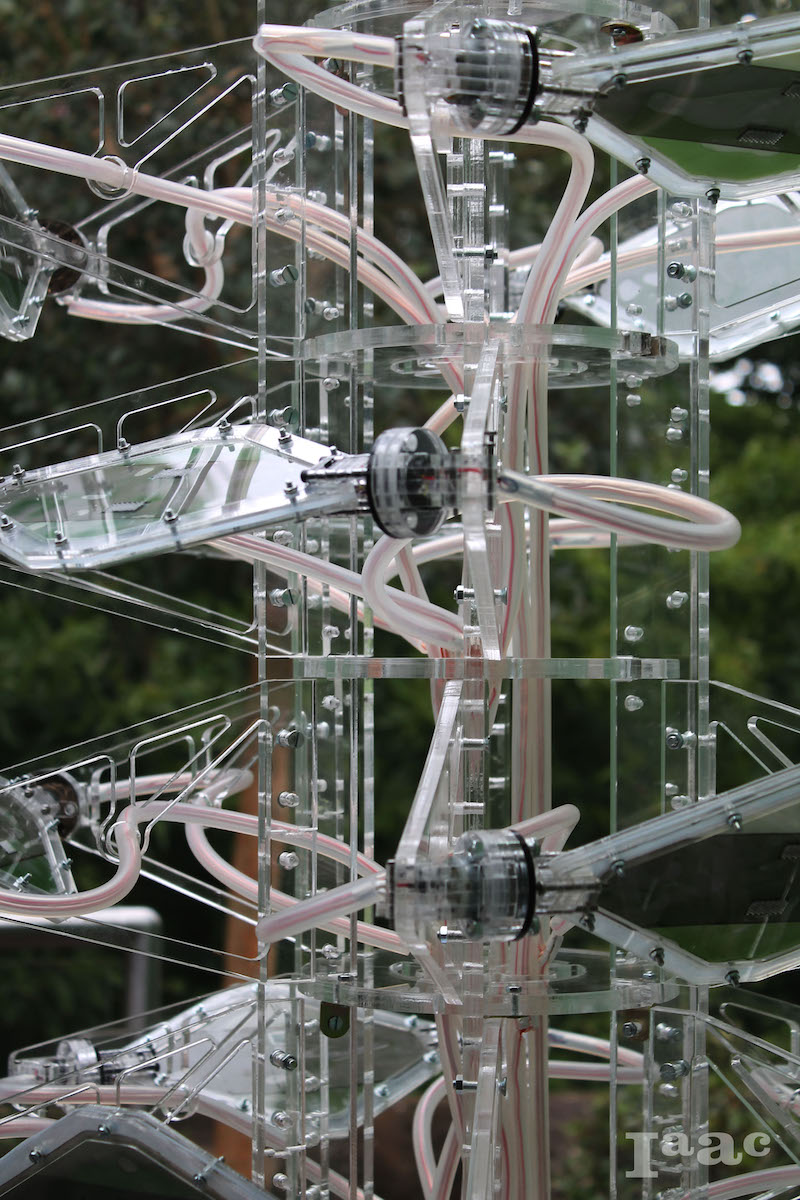
Thora H. Arnardottir and Jessica Dias are part of the BioCentric Design Group, working with living organisms to create energy and start conversations. [Photo: Courtesy of BioCentric Design Group]
BioCentric Design Group
Acrylic panels filled with algae spin in a mesmerizing array, catching visitors’ attention as they stop and wonder, “What is it?” Part art, part science project, it’s called the BioCatalytic Cell, and the possibilities for what it could be are endless.
The BioCatalytic Cell looks at how using a living organism can generate energy. The cells could even be used as a battery source, for example, a possibility that’s being researched. The project was designed by Thora H. Arnardottir and fellow students Jessica Dias and Christopher Wong at the Institute for Advanced Architecture of Catalonia (IAAC) as part of a seminar guided by Paolo Bombelli, a post-doctoral researcher in the biochemistry department at the University of Cambridge, where the technology behind the system was created.
In late 2016, Arnardottir and classmates were tasked to develop an easily assembled “kit of parts” that could show instant results. “Using living algal cells would provide an easy organism to maintain while allowing students to perform their own tests on the energy-generating abilities through the photosynthesis process,” Arnardottir says.
The group created an adaptive energy-sensing cell to harness the algae’s ability to harvest solar energy and generate electricity via the photosynthesis process. The biological solar cells are also called bioelectrochemical systems (BESs), or biophotovoltaic (BPV) devices.
But how does it work? Each cell panel rotates to agitate the algae and generate electricity through a network of conductive anode and cathode meshes with a carbon catalyst to transfer electrons from the cell surface to the electrode that harvests them. Connected tubing within the transparent structure allows the power output to sense the energy output and monitor the conditions in which algae can generate energy. The prototype is used as a biosensor to monitor and determine the best environmental conditions for algae to generate energy, testing three different algae cultures in various environments.
Today the BioCatalytic Cell is on display at IAAC, and a smaller version continues to be tested. But what was initially a student project ultimately became a bigger deal, as the students were invited to exhibit it at the London Zoo in June 2017 before the project traveled back to Barcelona for an exhibit with the Creative Europe Programme of European Union.
We recently talked with Arnardottir to find out more about the BioCatalytic Cell project, the BioCentric Design Group that formed as a result, and the world of possibilities that lies ahead.

[Photo: Courtesy of BioCentric Design Group]
gb&d: What is the BioCentric Design Group?
Arnardottir: The group was formed while we were studying for our master’s at IAAC. We randomly ended up in a group project in our first term studio called “Active Public Space: Eco-Machines” led by Claudia Pasquero and Carmelo Zappulla, and we worked on a project that focused on bioluminescent bacteria and bio-computation and how it reintroduces energy production into the public space. The glowing bacteria was no longer luminescent only in the squid it lives in, but on the skin. Furthermore, the bacterial light was activated by a person’s movement, thus the human body and the piece itself developed a symbiotic relationship.
This collaboration continued as we realized we all have a similar passion to engage in a more symbiotic relationship with nature, by understanding the natural patterns and processes and utilizing it in our design.
gb&d: How can something like the BioCatalytic Cell make a difference in the real world?
Arnardottir: This project sources living matter that grows in abundance to generate and harvest energy from the sun. In future iterations, for example where the casement material and electronic components could be more eco-friendly, this proposal could replace existing and expensive solar panels with a more cost-effective and natural solution.

[Photo: Courtesy of BioCentric Design Group]
gb&d: What was the biggest surprise to come out of this project?
Arnardottir: How engaged people are with it. It comes as a pleasant surprise how genuinely interested people are in getting to know how we can produce renewable, sustainable bio-energy with living organisms. I think we did not fully realize ourselves how incredible it is to see this green algae produce energy until we saw numbers on the multimeter. Although the power output from this setup is only able to generate approximately 55 millivolts per panel, it is enough to power an environmental sensor and be used to determine the more favorable conditions for this type of algal energy to be produced in.
gb&d: What did the BioCatalytic Cell ultimately teach you?
Arnardottir: The whole understanding of energy generation through a living organism was the highlight. None of us had done anything like that before so it was a real “learn as you go” move. I think there is also a level of respect for the algae and its many possibilities and limitations that fascinated us and grew our knowledge of working with it.
gb&d: You mentioned the group wanted to look at how harnessing solar energy through photosynthesis could be implemented into existing infrastructure. How can it?
Arnardottir: Future iterations of the cell itself could be implemented into existing public space infrastructure, not only to harvest solar energy but to encourage public engagement with the species and learn and spark an interest in new biotechnologies. We can implement this type of urban interaction in places that require some form of sun shading, as the panels would provide an obstruction from the sun and at the same time utilize it for generating electricity via the photosynthesis process.

[Photo: Courtesy of BioCentric Design Group]
gb&d: What does the future hold?
Arnardottir: For us, the unique selling point of biodesign is that it intersects with a variety of disciplines. The use of living systems and organisms in biodesign is not only to imitate nature but harness the machinery of those living systems to modify products or processes that can make our built environment more in line with nature. Our work is characterized by working with living organisms and other biomaterials, but we aim to synthesize biology and digital fabrication in the emerging field of biofabrication. We wish to encourage more designers and citizens to include biology in their work and expand their knowledge about the natural world around us.
gb&d: What else is the BioCentric Design group working on?
Arnardottir: We’re all working on different projects, by ourselves and together. One we are doing is with Physarum polycephalum, also known as slime mold, in collaboration with a Berlin-based artist and a glass designer in Barcelona, on slimy bio jewelry. The slime is a bright yellow, single-celled organism that branches out in search of nutrients. Through communication between the cells, a constant feedback loop demonstrates a spatial intelligence for finding the most efficient route to the nutrient source. We want to incorporate and showcase their ability in a wearable piece, and hopefully this will spark a sort of a connection between “us” and “them.”
